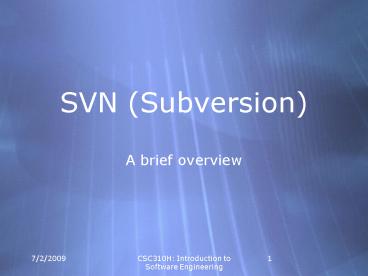SVN Subversion A brief overview - PowerPoint PPT Presentation
1 / 10
Title:
SVN Subversion A brief overview
Description:
Because people had no choice but CVS! ... Match CVS's features and preserve the same development model - Make it similar, so that any CVS user could switch to ... – PowerPoint PPT presentation
Number of Views:248
Avg rating:3.0/5.0
Title: SVN Subversion A brief overview
1
SVN (Subversion)A brief overview?
2
Why people use a version control system?
- The main benefit of using a version control
system is that it is to allows people to share
open source projects with ensuring changes made
by one developer are not accidentally removed or
altered when another developer posts their
changes to the projects
3
What is SVN?
- SVN or Subversion is a Software Engineering tool
which is used by many software developers to
maintain changes within their source code tree. - SVN is popular in the open source community and
used by many open source project, such as Apache
Software Foundation, KDE, GNOME, Python, and
etc. - SVN runs on all modern flavours of UNIX, Win32,
BeOS, OS/2, and MacOS X
4
SVNs History
- In early 2000, CollabNet Inc. tried to write a
replacement for CVS because of its limitation. - Bad News for them! CVS had become the de facto
standard in the open source world! Why? Because
people had no choice but CVS! - CollabNet determined to write a new version
control system from scratch! BUT based on CVS and
using CVS - Their objectives- Maintain version control
methodology- Match CVSs features and preserve
the same development model- Make it similar, so
that any CVS user could switch to it with little
effort - Finally, in August 2001 Subversion became free
from CVS!!!
5
Features of SVN
- Directory versioning- SVN implements a virtual
file system which tracks changes to whole
directory trees over time - True version history- can add, delete, copy, and
rename BOTH files and directories. - Atomic commits- prevent problems that can occur
when only a portion of a set of changes is
successfully sent to the repository. Revision
numbers are per-commit, not per-file log
messages are attached to the revision, not stored
redundantly as in CVS. - Versioned metadata- metadata of files and
directories can also be versioned. - Choice of network layers- Multiple repository
access protocols HTTP and HTTPS (Apache network
server option, with WebDAV/DeltaV protocol)?
6
Features of SVN (Continued)?
- Consistent data handling- Using a binary
differencing algorithm, works on both text and
binary files. File differences are transmitted in
both directions across the network (client
repository server)? - Efficient branching and tagging- create branches
and tags by copying projects (like hard-link),
take a small amount of time - Hackability- implemented as a collection of
shared C libraries. Extremely maintainable and
usable by other applications and languages.
7
SVN vs. CVS
- CVS
- Pros- widely used, well documented- supported
everywhere - Cons- allows to commit only files- slower-
intended to store text data, require
specialinformation for other types of files
- SVN
- Pros- versioned renames, moves of BOTH files and
directories- overall revision number easier
vesioning and regression testing- prevent
accidental committing of conflicted files-
support for custom diff command - Cons- need twice much space than CVS- no
rollback of commit need to store good repository
state to overwrite bad commit- not widely used,
more implementation is need
8
Subversions architecture
- On one end is a Subversion repository that holds
all of your versioned data. On the other end is
your Subversion client program, which manages
local reflections of portions of that versioned
data (called working copies). Between these
extremes are multiple routes through various
Repository Access (RA) layers. Some of these
routes go across computer networks and through
network servers which then access the repository.
Others bypass the network altogether and access
the repository directly.
9
SVNs current problems
- SVN does not have built-in tools which allow
permanent edits to the repository simply. Get
around dump the repository, editing the result
text file, and then recreate the repository. - Rename operation Use copy and delete, but still
use the same name in the older revisions.
Confusion would occur if one uses the old name to
create a new file and commit it to the
repository. - Subversion does not currently implement any
obliterate functionality to completely remove a
file from the repository and reclaim disk space - Subversion stores additional copies of data on
the local machine, which can be an issue for very
large projects or files, or if developers are
working on multiple branches simultaneously
10
More Info?
- There is a simple explanation of SVN on Wikipedia
? - SVN official webpage http//subversion.tigris.or
g/ - SVN documentation http//svnbook.red-bean.com/
- CVS to SVN Crossover Guide http//svn.collab.net
/repos/svn/trunk/doc/user/cvs-crossover-guide.html
- Subversion in GNOME http//developer.gnome.org/t
ools/svn.html - SVN Tutorial sites http//artis.imag.fr/Xavier.
Decoret/resources/svn/index.htmlhttp//www.german
e-software.com/ser/Files/Software/svntutorial.htm
l































